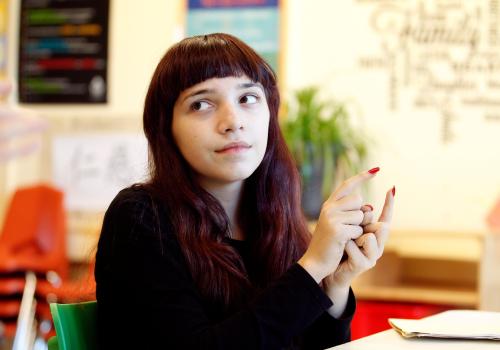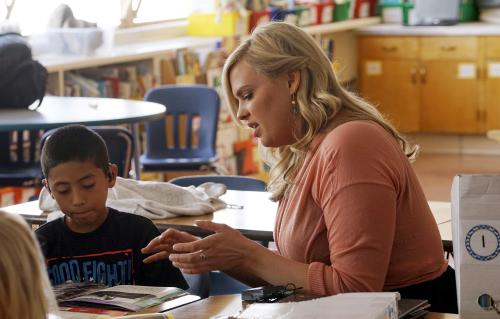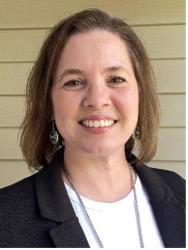In recognition of September as Deaf Awareness Month, the Brown Center Chalkboard invited commentary from Roberta J. Cordano, president of Gallaudet University. Editorial meetings also circled around questions of how deaf students fare in our public schools, and we sensed a need to better understand the experiences of deaf students and educators who support them. This led to an atypical source.
The following is an edited conversation between Michael Hansen, Senior Fellow in the Brown Center on Education Policy, and his oldest sister, Priscilla Hensley. Hensley serves as Secretary for the Idaho Association of the Deaf and is deaf herself. She also worked for several years as a para-educator supporting deaf students in her local public schools and has been involved with the Deaf community for many years beyond that. [Note: “Deaf” is often capitalized when referring to the broader, diverse Deaf community and culture, where lowercase “deaf” refers to the audiological condition.]
Hansen: Thank you for your willingness to inform our readers about public education from a deaf student’s perspective. Let’s start off with a definition of deafness and what that entails.
Hensley: The World Health Organization states that “a person who is not able to hear as well as someone with normal hearing—hearing thresholds of 20dB or better in both ears—is said to have hearing loss. Hearing loss may be mild, moderate, severe, or profound.” About 2 to 3 out of every 1,000 babies are born with a detectable level of hearing loss in one or both ears. People use a variety of labels for hearing loss, including “hard of hearing” or simply “deaf.”
Some people’s hearing loss can be mitigated through medical procedures (like cochlear implants) or technological devices (like hearing aids). Though I want to stress that these things do not “cure” hearing loss, as it still exists in two ways. First, these technologies vary in their impact on a deaf person’s ability to hear, and typically will not enable them to achieve normal hearing levels. Hearing aids and cochlear implants only amplify sound, they cannot always make sound comprehensible; this distinction is important.
And second, a deaf person’s ability to “hear” with corrections is still dependent on the technology itself, which may not always be there. On this point, my 18-year-old son recently remarked that I’m not deaf because I can “hear” and speak. In my attempt to correct his (common) misconception, I asked him, “When I remove my hearing aids, can I still hear?” Of course, the answer is no. Having tools that help me hear and function in society does not remove my deafness. If we lose access to these tools—for reasons ranging from a dead battery to prohibitive pricing for replacements—we are excluded from spoken language and the hearing world. A deaf person will always be a deaf person.
Hansen: What types of learning goals should educators have in mind for deaf students?
Hensley: A lot depends on what kind of support the student had in the early years before kindergarten. Early childhood educators know that young children need basic language to succeed in kindergarten, which means deaf students will need preschool support and exposure to American Sign Language (ASL).
With appropriate educational and language support, the learning objective for deaf students should be the same as hearing students. Many deaf students will graduate high school and go on to higher education, whether in college or a trade school. Low access to language (including visual learning), especially in the early years, however, creates barriers for some deaf students. Consequently, their graduation rates are not as high as their hearing peers, though they have been trending upward over time.
After completing their education, deaf people can do just about anything their hearing counterparts can do, though it is so much harder to find work at a livable wage because—sadly—many employers shy away from hiring deaf people, even though it’s a violation of federal law. I have seen brilliant people get passed over for positions, seemingly because of their hearing loss (and/or their reliance on sign language).
Hansen: The National Association of the Deaf recently estimated that more than 300,000 school-age children in the US are hearing impaired in some way, but only 75,000 students have Individualized Education Plans (IEPs) for receiving special education services. Not all deaf children are in public schools and thus won’t have an IEP, but this disconnect is shocking to me, as even modest hearing loss should warrant intervention. These numbers suggest many deaf and hearing-impaired students are not getting support.
Hensley: This is one manifestation of a recurring problem for deaf children. Since about 90% of deaf children are born to hearing families, many parents don’t know the rights their children have to services, both in school and in the community.
How this often plays out in schools is that the default preference for deaf children is to mainstream them in a general education classroom, as long as their hearing loss is corrected with technology and they can keep pace with their peers. Many hearing parents prefer the mainstreaming option, too, as they see mainstreaming their deaf child as preferable to sending them away to a school for the deaf. Some parents even see it as a success if their child does not receive special treatment for their hearing disability, though I don’t count this as a success. Far too many deaf kids are mainstreamed without sufficient support in my view.
As an aside—mainstreamed kids are often euphemistically labeled as merely hard of hearing (not deaf) even though they frequently have similar levels of hearing loss as those eligible for specialized instruction utilizing a visual language. While intended to reduce social stigma for the child, this mislabeling creates unnecessary barriers in accessing resources for deaf individuals and the broader Deaf community. That was my experience—I didn’t realize my hearing loss was severe enough to be considered deaf until I was an adult.
School districts need to be flexible in how they meet individual deaf students’ needs, providing the least restrictive, most language-rich environment possible. Some deaf children using cochlear implants, for example, may not need an interpreter but still need oversight from the district’s Teacher of the Deaf to make sure their progress still trends upward. Other students may need more access and a deaf school would be the best environment for them to thrive educationally and socially. There is a wide range of accommodations available for the students if school leaders are willing to research and implement it.
Roberta J. Cordano recently wrote about bilingual ASL-English policies, which would be amazing if implemented, though many districts won’t provide such a high level of support. Parents, teachers, interpreters, and others involved with the child’s educational needs should provide input to what would be best for the child; not what is best for the school district. But too often, important accommodation decisions ultimately boil down to funding.
Hansen: Can you tell us more about your experience as a public school student?
Hensley: I was mostly mainstreamed during my K-12 experience. I started preschool at a state-run deaf school and began learning ASL there. For K through second grade, I had an ASL interpreter with me at school. My family then moved to a different state right before third grade and for the first time, I found myself in a classroom with no interpreter, which became my new normal. The most common accommodation was sitting in the front row to read the teacher’s lips better. This is helpful, but only to a point—I never heard classmates’ questions and had to decode teachers’ one-sided responses.
In elementary school, I wore an auditory trainer that strapped around my chest with wires going to my ear connecting to an earpiece. The teacher wore a corresponding microphone, directly transmitting speech to the trainer. I discontinued using the device in junior high—mostly because it was hard to logistically manage getting the microphone from the teacher and setting up in my next class. But if I’m honest now, wanting to be more like my peers also played a big part in my decision to discontinue using it, despite its utility.
In my high school years, a notetaker for specific classes was added to my plan. The sharpest classmates were assigned to take notes using carbon paper, handing me the copy at the end of class. This was greatly beneficial because there were many things that I would otherwise miss.
Hansen: What was your experience like socially—friendships, extracurriculars?
Hensley: Growing up, I had friends in each grade. I was never in the popular group, but it didn’t bother me. Those who were my friends were good friends.
In high school, I became interested in one of the school dance teams. I took a couple of years of dance classes as gym electives, tried out, and made it! I was on the team for my junior and senior years and loved it. People find it surprising that I could be on a dance team. I could hear the music vaguely, but dancing to me was mostly about counting. I could also feel the bass vibrations well in many of the songs.
Hansen: How was your transition to college? Many might be concerned that a deaf young woman, minimally supported through most of K-12, may simply flounder in college.
Hensley: To the contrary, college really opened an entirely new world for me. Shortly after arriving on campus, I was introduced to an ASL Club and there I began really learning the language in earnest. Even though I hadn’t signed much since 2nd grade, I soaked up ASL like a sponge. It came to me naturally and quickly as if I knew it all my life. Though this personal development was bittersweet, too. On one hand, I came to realize the social and academic opportunities that I was missing out on when growing up, but on the other, it was my first real exposure into Deaf culture and I found my tribe.
Hansen: Many of our readers may be just newly aware of Deaf culture thanks to the public response to CODA, this year’s Academy Award-winning best picture, though I think most hearing people have infrequent interactions with deaf people and therefore have little understanding of the Deaf community.
Hensley: Yes, the Deaf community is often hidden in plain sight, but we’re here, too! We don’t look different from anyone else—and our language has perks: we can have conversations across the room and through windows!
Deaf culture is powerful. It’s critical in helping deaf people find support and thrive in the hearing world, while also providing social benefits to being in the community. Deaf children born to hearing families are often isolated and disconnected from Deaf culture, and I feel schools should be doing more to facilitate contact with the Deaf community to tap into those resources. ASL interpreters to help deaf kids keep up with classmates are great, though being connected to the larger Deaf community is transformative.
This is why working in the school district as a deaf person was such a powerful experience. It gave the students I interacted with the chance to see a deaf person succeeding. The fact that I went to college and have a job sends a powerful message to young deaf students. I like to think that being part of these students’ lives helped them to see the things they are capable of in their lives. In a perfect world, every family with a deaf child would have a Deaf mentor that they can use as a resource for life and school situations.
The authors thank Jill Radford, program lead for Deaf Education at Idaho State University, Stephanie Morrison, former Teacher of the Deaf, and Roberta J. Cordano, President of Gallaudet University, for feedback and helpful edits.








Commentary
Students with hearing loss need individualized support, access to Deaf community
October 6, 2022